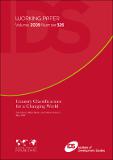| dc.description.abstract | The distinction between developing and developed countries has long been
central to development studies and to debates on development policy. In earlier
decades, it was in many respects accurate, and was for many purposes useful.
Although the world is still very much divided between rich and poor countries,
relationships among countries have changed so much that the developing–
developed country distinction has become an obstacle to understanding current
problems and opportunities and, even more, to thinking productively about the
future. It is time to stop using it. Many alternative ways of categorising countries
have been suggested. In recent years in particular, large numbers of
organisations have begun annually to rank countries according to a wide variety of
criteria: from economic vulnerability, bribe payers, competitiveness, digital access,
ease of doing business, food insecurity, governance, and happiness to water
poverty and welfare. These do not adequately capture the structural and relational
changes that have occurred in our multi-polar world with substantially altered
flows of ideas, resources and influence. Focusing on the needs of European
policymakers, this paper suggests two axes for classifying countries. The first is
the external capacity of states to influence and work with other states. This is
captured in the (measureable) concept of ‘anchor countries’ developed by the
German Development Institute and beginning to be put into practice in the
enlargement from the G8 to the G20. The second is internal state capacity, as
shaped by the sources of government income, in particular contrasting tax, aid,
and oil. Using sources of public revenue as a way of classifying countries requires
more work but would help to steer the development debate toward the key issue
of improving the quality of governance and thus strengthening the capacity of poor
countries to help themselves.
Keywords: development (general); country classification; country ranking;
national performance indicators; donor–recipient relationship; taxation; state
capacity; anchor countries; future of the world. | en_GB |

